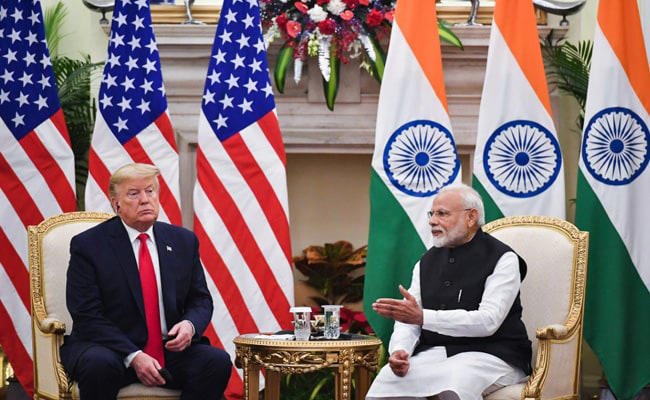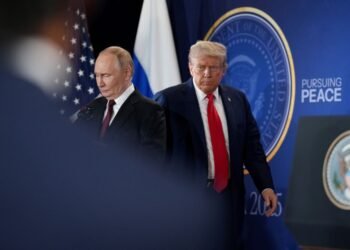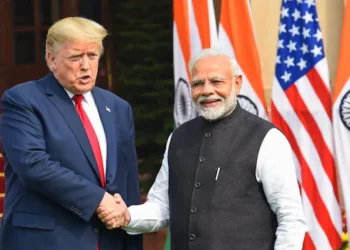Calling India a “friend” but criticizing its high tariffs and military purchases from Russia, Donald Trump announced a 25% import duty on Indian goods, effective August 1, along with an unspecified extra penalty.
BY PC Bureau
New Delhi, July 31, 2025 — India on Wednesday said it is closely assessing the implications of former U.S. President Donald Trump’s surprise announcement of a 25% tariff, plus additional penalties, on Indian imports beginning August 1. The move comes just days ahead of the sixth round of bilateral trade negotiations, scheduled for August 25 in New Delhi.
The timing of Trump’s announcement — made on his Truth Social platform — has raised eyebrows among diplomats and trade experts alike. It follows mounting tension over India’s energy and defense dealings with Russia, and appears to contradict the momentum building around a proposed U.S.-India trade agreement.
In an official statement, the Ministry of Commerce emphasized India’s willingness to continue negotiations for “a fair, balanced, and mutually beneficial bilateral trade agreement,” adding that the government remains committed to securing national interests.
Impact on India with 25% #Tariff as per Nuvama report
– Exports to US ($87B; ~2.5% of GDP) may fall
– Pharma, electronics, textiles, agri most exposed
– INR weakness may cushion some blowMarkets & Flows:
– FII flows may turn volatile
– Capital flight risk up
– RBI may need to…— Nigel D’Souza (@Nigel__DSouza) July 30, 2025
“India and the U.S. have been engaged in negotiations… over the last few months. We remain committed to that objective,” the statement read. “The government will take all steps necessary to secure our national interest, as has been the case with other trade agreements, including the recently concluded Comprehensive Economic and Trade Agreement with the UK.”
Trump, meanwhile, justified the tariff move by accusing India of “maintaining some of the highest tariffs and non-monetary trade barriers in the world.” He also cited India’s continued purchase of Russian arms and oil as a point of contention.
“While India is our friend, we have done relatively little business with them over the years because their tariffs are too high,” Trump wrote. “India will therefore be paying a tariff of 25 percent, plus a penalty, starting on August 1.”
Experts: Tariff Is a Pressure Tactic, But May Backfire
Trade analysts suggest the tariff announcement is designed to pressure India into concluding a deal quickly — part of Trump’s broader strategy to score rapid agreements with key trade partners like Japan, the UK, and the European Union. However, they caution that the move could backfire.
READ: Opinion | Did Modi’s LS Speech Invite the U.S. Tariff Bomb?
“This isn’t just about trade. The announcement intersects with geopolitics,” said Krishan Arora, Partner at Grant Thornton Bharat. “India’s growing energy and defense engagements with Russia appear to have become a flashpoint.”
Arora warned that the tariff shock could dent India’s economic recovery, particularly affecting exports of automobiles, electronics, processed food, and gems and jewelry. “If these measures persist, the impact on GDP could be significant,” he said.
His colleague Rishi Shah added that the finer details — especially the undefined “penalty” on top of the 25% duty — could deepen the damage. “The actual economic impact will depend heavily on how that penalty is structured,” he said. “Still, markets have shown resilience before and may adapt.”
Outlook: Fragile Trade Talks at Risk
While New Delhi continues to back dialogue, the tariff escalation risks derailing progress made in bilateral trade talks. Aditi Nayar, Chief Economist at ICRA, noted that earlier U.S. tariff moves had already led to a downward revision in India’s GDP forecast to 6.2% for FY26, based on expectations of sluggish exports and delayed private investment. “The new tariff-plus-penalty framework poses an even stronger headwind,” she warned.
With the August 25 trade talks looming, there is cautious optimism that both governments may seek a middle path to salvage negotiations. Some experts argue that an interim deal — or sectoral exemptions — may help contain the fallout.
However, business leaders are already advising Indian exporters to brace for impact and explore diversification strategies to cushion the blow. “The government must act decisively, but exporters also need to innovate and pivot quickly,” said Arora.
- Electronics & Smartphones
- U.S. tariffs will significantly impact India’s booming export segment—smartphones and electronic components—which saw exports surpass $24 billion in FY25. Apple’s iPhones, increasingly assembled in India for the U.S. market, would become notably more expensive
- Pharmaceuticals
- India supplies a large share of generics to the U.S.—accounting for approximately 40% of pharma exports. A 25% tariff could raise drug prices and disrupt supply chains in U.S. healthcare
- Textiles & Apparel
- The U.S. accounts for nearly 28% of India’s textile exports (~$10.8 billion annually). Vietnamese and Bangladeshi competitors with lower tariff exposure may displace Indian products in the American market 4. Gems, Jewelry & Leather
- Exporters of gemstones, jewelry, footwear, and leather goods face steep losses. U.S. duties would make Indian products uncompetitive relative to rival exporters
- Marine Products (Shrimp and Seafood)
- The U.S. is a major destination for Indian marine exports (~$2.4 billion). Tariffs could significantly erode margins and global competitiveness in seafood markets
- Auto Components
- India exports around $2.2 billion of auto parts annually to the U.S., largely supplying integrated automobile supply chains. Tariffs risk disrupting these flows and making components costlier .
Broader Economic Implications
- GDP Impact: Experts warn of a possible 20 basis-point decline in India’s GDP growth if the tariffs persist and no trade deal is finalized by September–October 2025
- Competitive Displacement: India may lose market share in sectors like textiles and electronics to competitors like Vietnam, Bangladesh, and Indonesia, who secured lower tariffs under existing U.S. trade agreements
- Strategic Supply Chain Disruption: Tariffs on key inputs and components—e.g., Indian copper exports or materials for tech manufacturing—may destabilize electronics and semiconductor ambitions
Summary Table
| Sector | Likely Impact |
| Electronics & Smartphones | Competitiveness eroded; price-sensitive U.S. consumers impacted |
| Pharmaceuticals | Higher U.S. drug costs; supply-chain disruptions |
| Textiles & Apparel | Loss of U.S. market share to regional rivals |
| Gems, Jewelry, Leather | Price shock; dampened demand in U.S. |
| Marine Products | Shrimp exports become less competitive |
| Auto Components | Disruption to supply chains; weaker margins |
Final Note
The 25% tariff and associated penalties mark a major escalation in India-U.S. trade friction. Key labour-intensive and export-driven sectors—from electronics to seafood—are exposed. While a full trade deal may yet offer relief, businesses and policymakers must prepare for immediate fallout and navigate uncertainty ahead.













